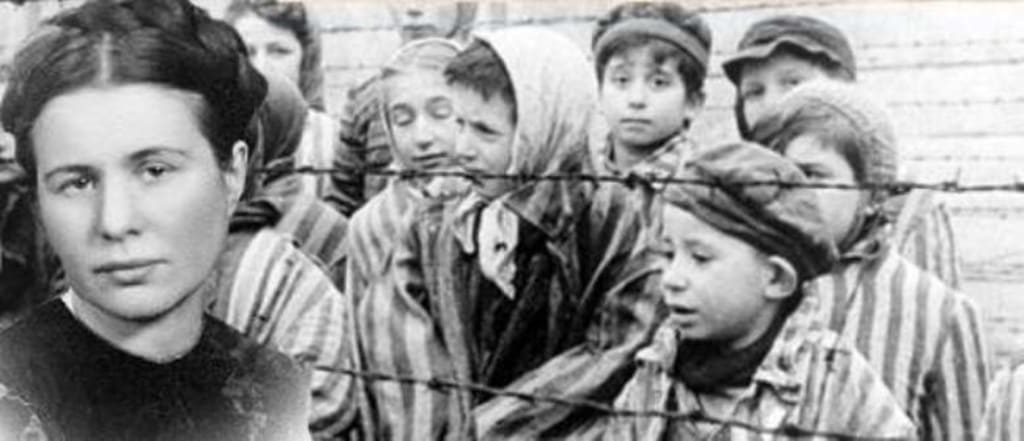Irena Sendler
An Angel During World War Two

“We all have to ask ourselves, “what would I have done?”” Many of us may never have heard of this woman but, fortunately, her bravery during World War Two is recorded within the pages of history. A Polish humanitarian, social worker and nurse, Irena helped to save Jewish childrens lives from the ‘Holocaust’ (concentration camps). Her unselfishness is an example to us all.
Irena was born on 15th February, 1910, in Warsaw. Her father was Dr.Stanislaw Krzyzanowski, a physician, and her mother was Janina. In 1917, the doctor died of typhus which he contracted while treating his patients, among them were many Jews. The other doctors refused to treat this ‘condition’ for fear of contracting it. At a very early age, Irena’s own father showed her the value of caring for fellow men and women. It was this same year that Irena got baptized in Otwock. When her father died, the Jewish community offered her mother financial help, although Janina declined their assistance (at that time).
Irena studied law for two years (from 1927) and then Polish literature at the University of Warsaw. By the outbreak of World War Two, Irena had submitted her ‘magister degree thesis’, but did not take her final exams. Irena was employed in a legal counselling and social help clinic.She published 2 pieces in 1934, both of which were concerned with the situation of children born out of wedlock and the mothers. She worked mainly in this field, seeing the extreme poverty of Warsaw’s neighbourhoods, and understanding that her clients were helpless, socially disadvantaged women. The government abolished this ‘section’ in 1935, Irena now became an employee in the Department of Social Welfare and Public Health.
Irena married twice in her life. Mieczyslaw Sendler in 1931 and, after divorcing him in 1947, she married Stefan Zgrzembski. With this husband, Irena had 3 children, Janina, Andrzei (who died in infancy) and Adam (who died of heart failure in 1999). In 1961, Zgrzembski died and Irena re-married her first husband, Sendler. 10 years later they divorced again.
When Germany was invaded, the German occupation authorities ordered Jewish staff to be removed from the Social Welfare Department (where Irena worked) and “barred the department from providing any assistance to Warsaw’s Jewish Citizens.” Irena was able to find a way of “assisting” some within the Jewish community, without the authorities knowing. With a few of her colleagues, Irena was able to create ‘false references’ and pursue ‘ingenious schemes’ inorder to help Jewish families and children, who were now excluded from the departments of Social Welfare.
400,000 Jews were crowded into a small portion of the city that was called the “Warsaw Ghetto” which was sealed by the Nazis in November, 1940. Irena and several colleagues were able to gain access, with special permits, to enter the ghetto to check for signs of typhus. Under the ‘pretext’ of conducting sanitary inspections, they were able to provide medicines and cleaning items as well as sneaking in clothing, food and other necessities. They eventually managed to ‘smuggle’ babies and small children from the ghetto using various ‘ways.’ This took tremendous courage because if they had been caught, not just Irena and her colleagues would have been shot by the Nazis, but their families also.
During the “Great Action” (the code name the Nazis’ used for the deportation and mass murder of the Jews), Irena kept trying to enter the ghetto in a desperate attempt to save as many Jews as she could. “Every child saved with my help is the justification of my existence on this Earth, and not a title to glory,” a quote made by Irena Sendler. Her ‘work’ became known as “life In a Jar” because in 1943, Irena was arrested by the Gestapo and as they ransacked her house, they found nothing, because Irena and her ‘friends’ had already buried the list of the children they had helped --- in jars. The Gestapo took Irena to their headquarters and she was brutally beaten. Despite this ‘torture’, she never betrayed the children or her friends. She was then taken to the Pawiak prison, where Irena was again interrogated and beaten, and on the 13th November, Irena was taken to another location, to be executed by firing squad. The German soldiers escorting her were bribed and Irena ‘escaped’ on her way to the execution.
Remaining in hiding, Irena worked under the name of Klara Dabrowska as a nurse, and in 1943, resumed helping the Jewish children with “Zegota.” Irena continued working as a nurse until the Germans left Warsaw. Over the next few years, Irena continued helping these children (with the help of many ‘friends’), but most of their parents had already been killed at the Treblinka extermination camp. These kind people wanted to re-unite the children with “their nation”, but --- how? Most of the children were taken out of Poland.
Irena Sendler received at least 6 decorations ‘for the wartime saving of the Jews.’ Irena continued ‘her work’ after the War, working long hours in various social work programs, helping the teenage prostitutes that were in the ruins of post-war Warsaw, and organizing a number of orphanages and care centers for children, families and the elderly. In 1980, Irena joined the Solidarity movement and lived the rest of her life in warsaw. Irena Sendler died on 12th May, 2008, at 98 years of age and is buried in Warsaw’s Powazki Cemetery.
Before her death, in 1991, Irena was made an honorary citizen of Israel, having already been recognized by Yad Vashem as one of the “Polish Righteous Among The Nations”, in 1965, for her courage in saving so many lives within the Jewish community.
“Zegota'' was the Council for Aid to Jews and was organized by the Polish underground resistance movement. Irena was one of its first recruits in helping to rescue the Jewish children. Some of these Jewish children were taken out of the ghetto in gunnysacks or body bags. Others were buried inside loads of goods. One mechanic took a baby out in his toolbox. Some were carried out in potato sacks, coffins or by entering a church which had 2 entrances. They entered the church as Jews and exited as Christian, having been given false identities and placed in homes, orphanages and convents. “No one ever refused to take a child from me,” Irena recalled. The only record of the true identities of these children were buried in jars beneath an apple tree in a neighbour’s backyard. Later, it was found that these jars contained the names of 2,500 children. The children only knew Irena by her code name “Jolanta.” It was found out later that during her beatings by the Gestapo, both her feet and legs were broken --- still Irena Sendler refused to give up any names, whether the Jewish children or her ‘friends.’
No-one could break Irena’s spirit!
(My research comes from Wikipedia / the Jewish Virtual Library and “Life In a Jar”)
About the Creator
Ruth Elizabeth Stiff
I love all things Earthy and Self-Help
History is one of my favourite subjects and I love to write short fiction
Research is so interesting for me too






Comments
There are no comments for this story
Be the first to respond and start the conversation.